Thursday, October 30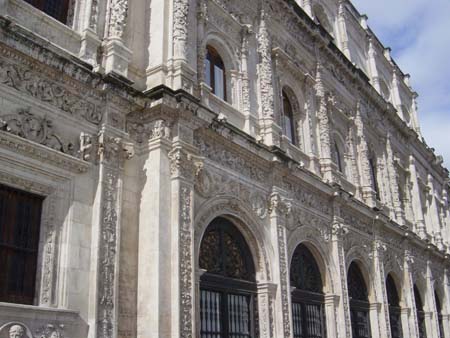
Paula: We started our day exploring Seville by taking
a walking tour of the city. We have found that this often familiarizes us
with the history of an area and orients us to all the major sites and areas.
By the end of a typical city walking tour, we know where we want to spend
more time. 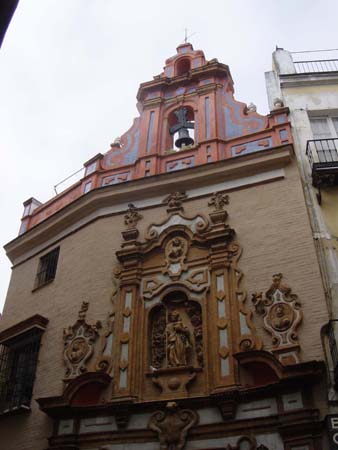
The tour started in the "new" town square built in the 18th century. Here we learned about the town's patron saint Fernando whose tomb is opened every May to celebrate his life. We quickly discovered that Seville has a Catholic Church on every corner and that the residents all belong to one of 57 brotherhoods. These brotherhoods sponsor the floats during the Easter holy week parades that Seville is well know for. The brotherhoods remove relics from their churches to place on the floats and parade down Sierpes-Seville's most popular street. Today when we walked down Sierpes, we noticed that this pedestrian area is home to many shops and street musicians.
The first church we visited was St. Joseph's Cathedral. The cathedral done
in baroque style was small but lavish on the inside and contained more gold
and silver than we have seen in all our travels. There are many relics (bones
of saints) and the statues of Mary and Christ are manikin-like with tears
and blood stains. Our guide commented that in Seville the people worship so
many saints that some feel that their religion is almost "pagan-like."
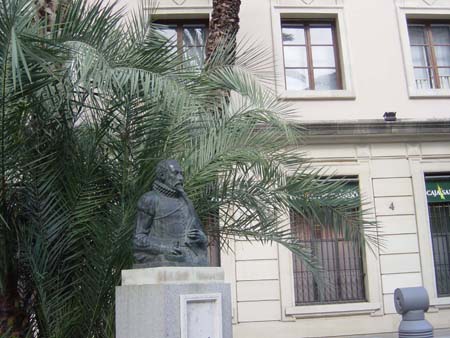
David and Katie enjoyed seeing the prison (it's now a bank with a statue
of Cervantes outside) where Miguel de Cervantes spent five years and during
this time began writing his famous novel, Don Quixote. They are both familiar
with the tales of Don Quixote from their Spanish classes. The prison was just
off Plaza de San Francisco, the main square for Seville until the 18th century.
It was in this square that public executions were performed as well as bull
fights. The square was originally the site of the Franciscan Missions who
were largely responsible for developing the trade network in the Americas.
The trade with the Americas in the 1500's made Seville the wealthiest city
in the world during that time period. 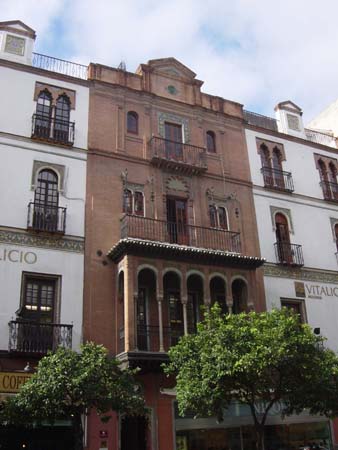
The city has a variety of architectural styles and on many streets buildings
of different styles stand one after the other. Our guide explained while modernism
was in style in Barcelona, here in Seville buildings were constructed in neo-Moorish
(Muslim style), neo-Renaissance, neo-Gothic and neo-Baroque. 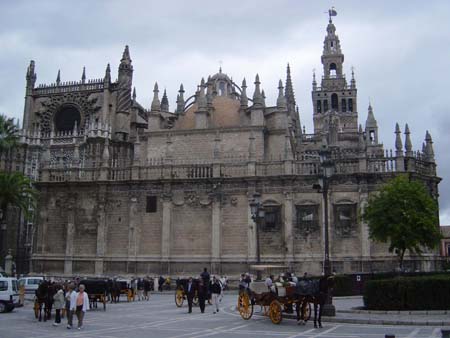
The Cathedral of Seville stands in the heart of the old city and is the third
largest cathedral in the world (St. Peter's is the largest and St. Paul's
in London the second largest). It was built on top of a mosque from the 12th
century and there are still visible signs of the mosque including its fountain
for ablutions and a beautiful archway and doors carved with passages from
the Koran. The minaret of the mosque was turned into a bell tower for the
gothic cathedral. It looked very similar to the 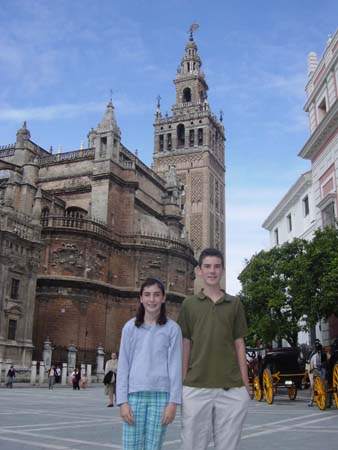 minarets
we saw in Morocco and in fact an identical but smaller version of this minaret
was used in the Koutoubia Mosque in Marrakech.
minarets
we saw in Morocco and in fact an identical but smaller version of this minaret
was used in the Koutoubia Mosque in Marrakech.
We learned that the Muslims had used the stones from the Roman temples in
Seville to construct the minaret and several of the foundation stones had
Roman inscriptions. Excavations have revealed pieces of hundreds of Roman
statutes apparently destroyed by the Muslims and used as construction material.
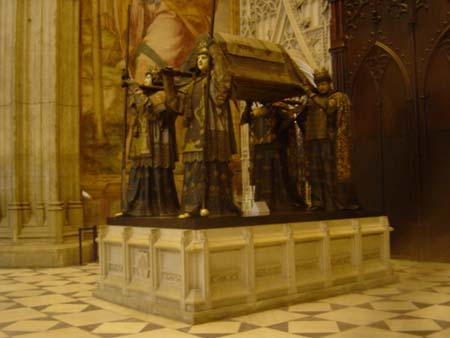
Later in the afternoon we returned to visit the inside of the cathedral and
were amazed by its size and the riches within. It is so large that Notre Dame
Cathedral could be placed inside. We found it amusing to see a certificate
displayed from the Guinness Book of World Records proclaiming the Cathedral
of Seville as having the largest volume of any cathedral in the world. More
impressive was the high alter with over 1,000 statues and huge amounts of
g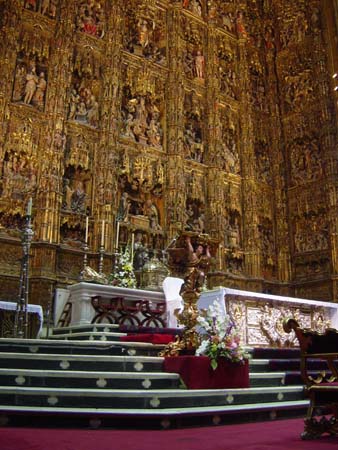 old.
The choir contains 117 lavishly wood carved stalls, and we enjoyed seeing
many other beautiful chapels and famous pieces of art. Our favorite part of
the cathedral was the tomb of Christopher Columbus. His remains (which have
recently been confirmed by DNA testing) are held high in a crypt by four statues
representing the four kingdoms at the time of Columbus' life. Although we
have seen many churches on our trip, this cathedral is one of our favorites
and will have a lasting impression on us.
old.
The choir contains 117 lavishly wood carved stalls, and we enjoyed seeing
many other beautiful chapels and famous pieces of art. Our favorite part of
the cathedral was the tomb of Christopher Columbus. His remains (which have
recently been confirmed by DNA testing) are held high in a crypt by four statues
representing the four kingdoms at the time of Columbus' life. Although we
have seen many churches on our trip, this cathedral is one of our favorites
and will have a lasting impression on us.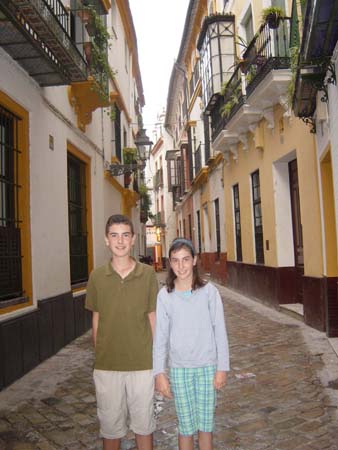
We walked through the Plaza de Santa Cruz which was the old Jewish Quarters. The area is close to the Alcazar (famous palace here that we will visit tomorrow) because the Jews were the bankers for the ruling families. Our guide explained that the Jews were expelled in 1493 and most moved to Morocco never to return. Apparently many of the families kept the keys of their homes here hoping to someday return and these keys have been passed down from generation to generation. The Jewish Quarter is quaint with narrow winding streets and small courtyard cafes.
We also enjoyed a nice late lunch at Taberna Alabardero. Like the rest of Europe, the Spanish traditionally eat a late lunch, usually between 2:00 and 4:00 each day. We imagine that they must all take naps as well since as we noticed last night they also stay up and eat very late in the evening. Our meals included traditional Spanish ingredients - rice, beans, olives, meats all cooked with generous amounts of olive oil, garlic and spices.
We enjoyed our first day in Seville but feel we have not yet seen the vibrant and colorful street life we expected. This may be the downside of visiting outside the high season. The streets seem busy with students and people working, and we haven't seen the strolling musicians and outdoor activities that are more common during the summer months.
Tomorrow we'll explore other parts of Seville, including the Alcazar palace and the river area. We also have tickets to a flamenco dance, which we're very much looking forward to.
Distance Walked: 3.83 miles
